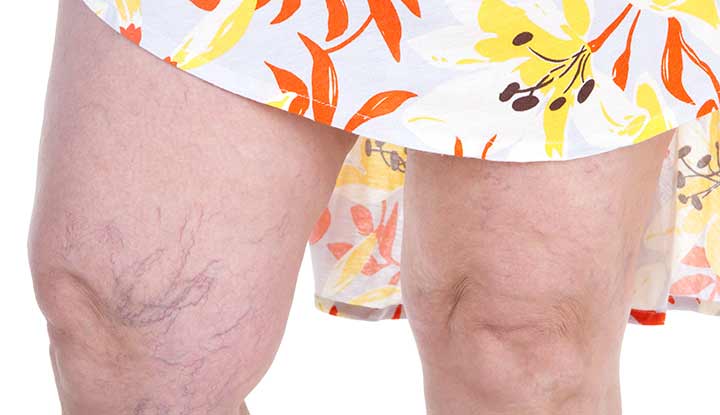Spider veins are damaged blood vessels just under your skin that look red, blue or purple. They’re usually harmless. Spider veins don’t typically cause any symptoms, but rarely, may cause burning, itching or discomfort (especially in your legs). Treatments can get rid of spider veins and help you feel better about your skin’s appearance.
Advertisement
Cleveland Clinic is a non-profit academic medical center. Advertising on our site helps support our mission. We do not endorse non-Cleveland Clinic products or services. Policy

Spider veins (telangiectasias) are damaged, visible blood vessels just beneath your skin’s surface. They typically look red, blue or purple. They may appear in clusters that resemble spider webs or tree branches. Spider veins can form anywhere, but they usually develop in your legs or face.
Advertisement
Cleveland Clinic is a non-profit academic medical center. Advertising on our site helps support our mission. We do not endorse non-Cleveland Clinic products or services. Policy
Spider veins are typically harmless. They only need treatment if you don’t like the way they look. Treatment is often successful in getting rid of them. You may also want to make lifestyle changes to help keep new ones from forming.
There’s usually no need to worry. Spider veins aren’t dangerous by themselves. They simply mean some small blood vessels are damaged. Spider veins are mostly a cosmetic issue, meaning you might not like their appearance, but they won’t harm you.
Sometimes, though, spider veins are an early sign of chronic venous insufficiency (CVI). This is a vein disease that can affect your quality of life and lead to complications.
If you notice spider veins, talk to a healthcare provider. They can give you a physical exam and check to see if you have risk factors for CVI.
Spider veins are common. They affect more than 50% of women, and they become even more common after age 80.
Spider veins are more common among women compared to men.
Spider veins aren’t actually veins. They’re damaged capillaries, venules and arterioles. These are all small blood vessels that connect with larger blood vessels as part of your circulatory system. But the term “spider veins” is easy to say and remember.
Advertisement
Varicose veins are damaged veins. Veins are larger blood vessels that carry oxygen-poor blood back toward your heart. Varicose veins are usually larger than spider veins and tend to bulge outward from your skin.
Spider veins rarely cause symptoms, and people seek treatment for cosmetic reasons. Varicose veins often cause symptoms like leg pain and discomfort. So, people seek varicose vein treatment for cosmetic reasons or to ease symptoms.
Many people who have spider veins also have varicose veins. This is because they share many of the same causes and risk factors.
Spider veins form when small blood vessels just under your skin weaken and expand. It’s not always clear what causes this to happen. Some known causes include:
You may face a higher risk for spider veins if you:
Spider veins don’t cause symptoms. A small number of people with spider veins in their legs experience the following symptoms, especially after standing awhile:
However, these symptoms are often unrelated to the spider veins, and treating the spider veins doesn’t improve these symptoms.
Spider veins on their own rarely lead to complications. But if you also have other conditions, such as CVI, you may be at risk for venous stasis ulcers or cellulitis. It’s important to talk to a provider about the health of your blood vessels and signs of complications you should look out for.
To diagnose spider veins, a healthcare provider will:
Your provider will look for signs of CVI to determine if your spider veins signal a more serious blood flow problem. If you have CVI, you may need to see a vascular surgeon for further evaluation and treatment.
Spider vein treatments include:
Advertisement
If you’re considering treatment, talk to a provider about what’s best for you. It’s important to keep in mind that providers will look for and treat more serious issues before treating your spider veins. For example, if you have signs of CVI, such as varicose veins or venous stasis ulcers, your provider will treat those issues first.
Spider veins usually don’t lead to serious problems. Treatment usually gets rid of them and helps you feel better about your skin’s appearance. You may need treatment again in the future if new spider veins form.
If you have CVI, it’s important to talk to a healthcare provider about what you can expect going forward
Self-care can sometimes help prevent new spider veins from forming. Tips include:
Advertisement
Follow your provider’s advice for lifestyle changes that may improve blood flow. Common tips include:
If you have any concerns about your blood vessels, call your provider and schedule a checkup.
You should also call your provider if:
Talk to your healthcare provider about your spider veins and what they mean for you. Questions to ask include:
Advertisement
You might not be a fan of how your spider veins look. But rest assured, they’re usually harmless, and treatment can often make them go away. Still, it’s always a good idea to talk to a healthcare provider about any new spider veins you notice. They can sometimes be an early sign of more serious blood flow problems. Ask your provider about lifestyle changes that can help keep new spider veins from forming.
Vascular disease may affect your life in big and small ways. Cleveland Clinic’s specialists treat the many types of vascular disease so you can focus on living.

Last reviewed on 12/29/2022.
Learn more about the Health Library and our editorial process.